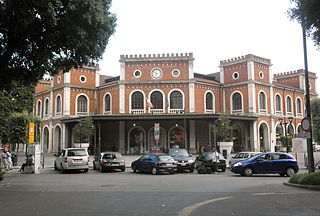
Lombardy is an administrative region of Italy that covers 23,844 km2 (9,206 sq mi); it is located in northern Italy and has a population of about 10 million people, constituting more than one-sixth of Italy's population. Lombardy is located between the Alps mountain range and tributaries of the river Po, and includes Milan, its capital, the largest metropolitan area in the country, and among the largest in the EU.

Gian Galeazzo Visconti, was the first duke of Milan (1395) and ruled that late-medieval city just before the dawn of the Renaissance. He also ruled Lombardy jointly with his uncle Bernabò. He was the founding patron of the Certosa di Pavia, completing the Visconti Castle at Pavia begun by his father and furthering work on the Duomo of Milan. He captured a large territory of northern Italy and the Po valley. He threatened war with France in relation to the transfer of Genoa to French control as well as issues with his beloved daughter Valentina. When he died of fever in the Castello of Melegnano, his children fought with each other and fragmented the territories that he had ruled.

Milano Centrale is the main railway station of the city of Milan, Italy, and is the second busiest railway station in Italy for passenger flow and the largest railway station in Europe by volume.
Ponte, a word meaning bridge in Italian, Portuguese, and Galician languages, may refer to:

Bologna Centrale is the main railway station in Bologna, Italy. The station is situated at the northern edge of the city centre. It is located at the southern end of the Milan-Bologna high-speed line, which opened on 13 December 2008, and the northern end of three lines between Bologna and Florence: the original Bologna-Florence line through Porretta Terme and Pistoia; the Bologna–Florence Direttissima via Prato, which opened on 22 April 1934 and the Bologna-Florence high-speed line, which opened to traffic on 13 December 2009.

The Kingdom of Lombardy–Venetia, commonly called the "Lombardo-Venetian Kingdom", was a constituent land of the Austrian Empire from 1815 to 1866. It was created in 1815 by resolution of the Congress of Vienna in recognition of the Austrian House of Habsburg-Lorraine's rights to the former Duchy of Milan and the former Republic of Venice after the Napoleonic Kingdom of Italy, proclaimed in 1805, had collapsed.
Museums of modern art listed alphabetically by country.

The Milan–Venice railway line is one of the most important railway lines in Italy. It connects the major city of Milan, in Lombardy, with the Adriatic Sea at Venice, in Veneto. The line is state-owned and operated by the state rail infrastructure company, Rete Ferroviaria Italiana that classifies it as a trunk line. The line is electrified at 3,000 volts DC.
The Trans-European conventional rail network, together with the Trans-European high-speed rail network, make up the Trans-European Rail network, which in turn is one of a number of the European Union's Trans-European transport networks (TEN-T). It was defined by the Council Directive 2001/16/EC of 19 March 2001.
This page is based on this
Wikipedia article Text is available under the
CC BY-SA 4.0 license; additional terms may apply.
Images, videos and audio are available under their respective licenses.





